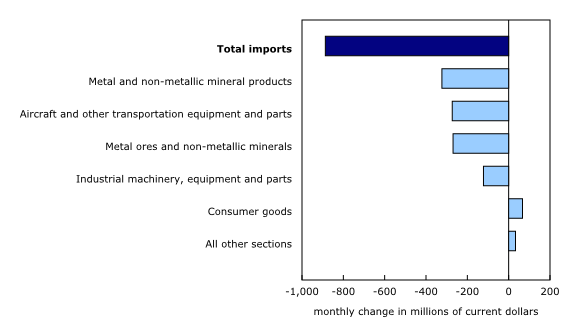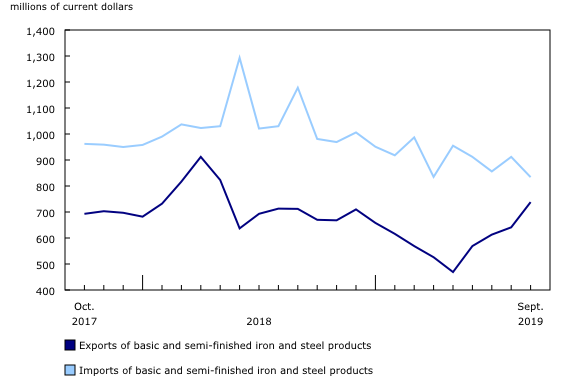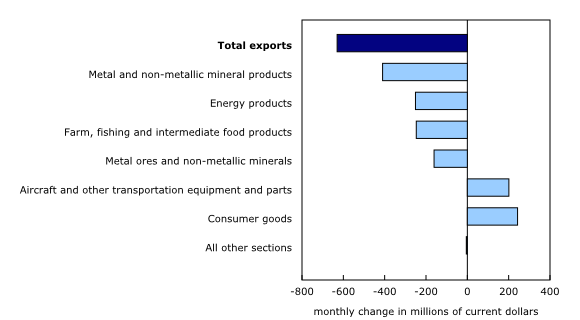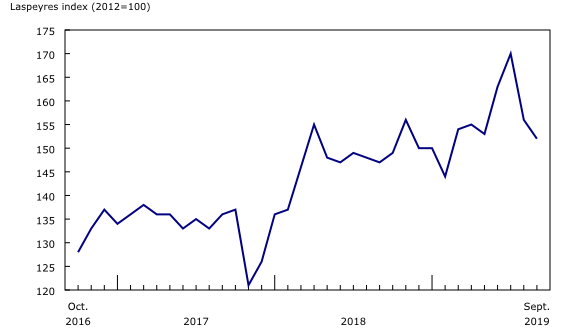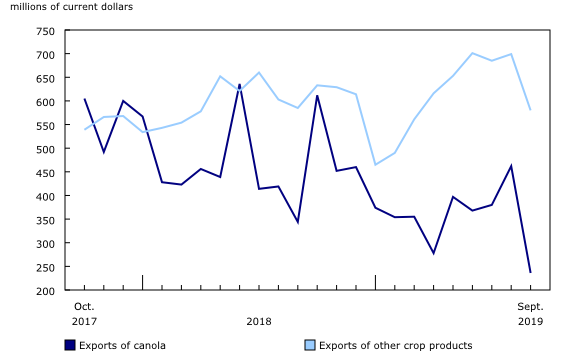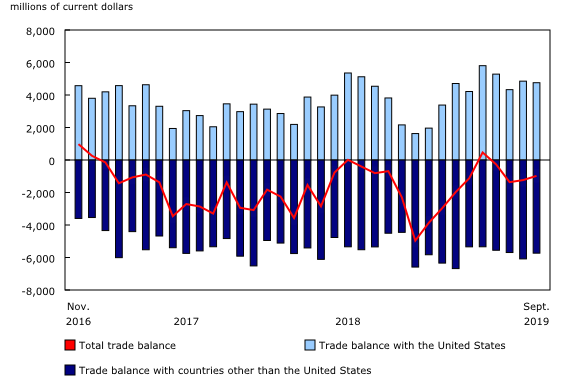Canadian international merchandise trade, September 2019
Archived Content
Information identified as archived is provided for reference, research or recordkeeping purposes. It is not subject to the Government of Canada Web Standards and has not been altered or updated since it was archived. Please "contact us" to request a format other than those available.
Released: 2019-11-05
Canada's imports fell 1.7% in September, while exports declined 1.3%. As a result, Canada's merchandise trade deficit with the world narrowed from $1.2 billion in August to $978 million in September.
Decline in gold imports
Total imports fell 1.7% to $50.8 billion in September. Declines were observed in 7 of 11 product sections, while the other sections posted modest increases. Total imports in the first nine months of the year were up 1.7% compared with the same period in 2018. In real (or volume) terms, imports were down 1.6% in September.
After increasing 9.2% in August, imports of metal and non-metallic mineral products decreased 9.2% in September. Gold imports contributed the most to the drop in September, after increasing in August on higher acquisitions of gold assets. Lower imports of iron and steel products were also observed in September. In contrast with exports, imports of iron and steel products have not yet posted a significant rebound after tariffs were lifted on many of these products in May.
Imports of other transportation equipment and parts (-27.7%) were also down in September, mainly due to lower imports of parts for other transportation equipment from Belgium. Following significant increases in July and August, these imports—which historically have shown high volatility—returned to June levels in September.
Imports of metal ores and non-metallic minerals fell 20.5% in September, mostly due to lower imports of gold and copper ores. Following increases in July and August, imports of gold for refining declined in September, mainly on lower shipments from Peru, Japan and Brazil. Copper ore imports returned to levels similar to July, after a sharp increase in imports from the Philippines in August.
Declines in gold and crude oil exports
Total exports fell 1.3% to $49.8 billion in September, largely offsetting the increase in August. Decreases were observed in 7 of 11 product sections. Despite the monthly decrease, total exports since the beginning of 2019 were up 1.9% compared with the same period in 2018. Expressed in real (or volume) terms, exports declined 2.1% in September.
Exports of metal and non-metallic mineral products (-7.3%) posted the largest decline in September, mostly on lower gold exports (-$371 million). After two consecutive monthly increases, exports of refined gold fell in September, largely offsetting all the gains in July and August. This decrease was partially offset by higher exports of articles of gold, a similar product classified under miscellaneous goods and supplies (+$254 million) in the consumer goods section.
Exports of energy products also declined in September, due to lower crude oil exports (-2.1%). After rising in August on higher prices, crude oil exports were down on account of lower volumes. This was the second consecutive monthly volume decrease after the peak observed in July. This recent decline coincides with decreased production at certain Canadian North Atlantic oil platforms, as well as at certain refineries in the American Midwest.
Exports of farm, fishing and intermediate food products fell 7.3% in September. Canola exports (-48.9%) contributed the most to this decline, reaching their lowest level in more than six years. Since the beginning of 2019, canola exports were down 22.3% compared with the same period in 2018, mainly due to a sharp decline in exports to China. Exports of other crop products (mainly soybeans) also posted a significant decrease in September, however they were up 2.2% year to date in 2019 compared with the same period in 2018.
Partially offsetting these declines were exports of other transportation equipment and parts, which almost doubled, driven largely by higher exports of other transportation equipment to Saudi Arabia. Exports for this category have been volatile in 2019; overall, they rose 32.9% in the first nine months of the year compared with the same period in 2018.
Trade activity with countries other than the United States decreases
Imports from countries other than the United States fell 4.1% in September. Lower imports from Belgium (parts for other transportation equipment) and Switzerland (pharmaceutical products) were partially offset by higher imports from China (cellphones) and the United Kingdom (various products).
Exports to countries other than the United States decreased 3.3%, the second consecutive monthly decline. Lower exports to the Netherlands (crude oil and iron ore), India (coal and potash), Norway (nickel) and Mexico (canola) contributed the most to the decrease. As a result, Canada's trade deficit with countries other than the United States narrowed from $6.1 billion in August to $5.7 billion in September.
Exports to the United States were down 0.6% in September, while imports edged down 0.4%. As a result, Canada's trade surplus with the United States decreased slightly from $4.9 billion in August to $4.8 billion in September.
When the average exchange rates of August and September are compared, the Canadian dollar gained 0.2 US cents relative to the American dollar.
Export slowdown in the third quarter after a significant increase in the second quarter
After posting 4.8% growth in the second quarter, exports fell 2.3% in the third quarter. Lower exports of energy products were responsible for more than two-thirds of the decrease. Imports were down 0.6% in the third quarter. The product sections posting the largest decreases were energy products (-4.4%) and motor vehicles and parts (-1.2%).
In real (or volume) terms, exports were down 0.5% in the third quarter, after increasing 3.5% in the second quarter. Real exports of aircraft and other transportation equipment and parts led the decrease in the third quarter. Meanwhile, import volumes rose 1.6% in the third quarter, driven partly by motor vehicles and parts.
Revisions to August exports and imports
Revisions reflect initial estimates being updated with or replaced by administrative and survey data as they become available, as well as amendments made for late documentation of high-value transactions. Exports in August, originally reported as $50.6 billion in the previous release, were revised to $50.4 billion. Imports in August, originally reported as $51.5 billion in the previous release, were revised to $51.6 billion in the current month's release.
Note to readers
Merchandise trade is one component of Canada's international balance of payments (BOP), which also includes trade in services, investment income, current transfers, and capital and financial flows.
International trade data by commodity are available on both a BOP and a customs basis. International trade data by country are available on a customs basis for all countries and on a BOP basis for Canada's 27 principal trading partners (PTPs). The list of PTPs is based on their annual share of total merchandise trade—imports and exports—with Canada in 2012. BOP data are derived from customs data by making adjustments for factors such as valuation, coverage, timing and residency. These adjustments are made to conform to the concepts and definitions of the Canadian System of National Accounts.
For a conceptual analysis of BOP versus customs-based data, see "Balance of Payments trade in goods at Statistics Canada: Expanding geographic detail to 27 principal trading partners."
For more information on these and other macroeconomic concepts, see the Methodological Guide: Canadian System of Macroeconomic Accounts (13-607-X) and the User Guide: Canadian System of Macroeconomic Accounts (13-606-G).
Data in this release are on a BOP basis and are seasonally adjusted. Unless otherwise stated, values are expressed in nominal terms, or current dollars. References to prices are based on aggregate Paasche (current-weighted) price indexes (2012=100). Volumes, or constant dollars, are calculated using the Laspeyres formula (2012=100).
For information on seasonal adjustment, see "Seasonally adjusted data – Frequently asked questions."
Revisions
In general, merchandise trade data are revised on an ongoing basis for each month of the current year. Current-year revisions are reflected in both the customs and BOP-based data.
The previous year's customs-based data are revised with the release of the January and February reference months, and thereafter on a quarterly basis. The previous two years of customs-based data are revised annually, and revisions are released in February with the December reference month.
The previous year's BOP-based data are revised with the release of data for the January, February, March and April reference months. To remain consistent with the Canadian System of Macroeconomic Accounts, revisions to BOP-based data for previous years are released annually in December with the October reference month.
Factors influencing revisions include the late receipt of import and export documentation, incorrect information on customs forms, replacement of estimates produced for the energy section with actual figures, changes in classification of merchandise based on more current information, and changes to seasonal adjustment factors.
For information on data revisions for crude oil and natural gas, see "Revisions to trade data for crude oil and natural gas."
Revised data are available in the appropriate tables.
Real-time data table
Real-time table 12-10-0120-01 will be updated on November 18.
Next release
Data on Canadian international merchandise trade for October will be released on December 5.
Products
The product "International Trade Explorer" (71-607-X) is now available online. This product provides a new way of looking at Canada's trade relations. Leveraging the analytical richness of customs data, this product offers four different visualization tools: an interactive world map, a tree map, a stacked bar chart and a visualization tool for trade by province.
Customs-based data are now available in the Canadian International Merchandise Trade Database (65F0013X).
The updated Canada and the World Statistics Hub (13-609-X) is now available online. This product illustrates the nature and extent of Canada's economic and financial relationship with the world using interactive graphs and tables. This product provides easy access to information on trade, investment, employment and travel between Canada and a number of countries, including the United States, the United Kingdom, Mexico, China, Japan, Belgium, Italy, the Netherlands, Spain and many others.
Contact information
For more information, or to enquire about the concepts, methods or data quality of this release, contact us (toll-free 1-800-263-1136; 514-283-8300; STATCAN.infostats-infostats.STATCAN@canada.ca) or Media Relations (613-951-4636; STATCAN.mediahotline-ligneinfomedias.STATCAN@canada.ca).
- Date modified:




